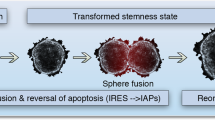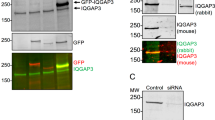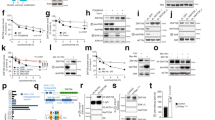Abstract
The viability of vertebrate cells depends on survival factors which activate signal transduction pathways that suppress apoptosis. Defects in anti-apoptotic signalling pathways are implicated in many pathologies including cancer, in which apoptosis induced by deregulated oncogenes must be forestalled for a tumour to become established. Phosphatidylinositol-3-kinase (PI(3)K) is involved in the intracellular signal transduction of many receptors and has been implicated in the transduction of survival signals in neuronal cells1. We therefore examined the role of PI(3)K, its upstream effector Ras2, and its putative downstream protein kinase effectors PKB/Akt3,4 and p70S6K (ref. 5) in the modulation of apoptosis induced in fibroblasts by the oncoprotein c-Myc. Here we show that Ras activation of PI(3)K suppresses c-Myc-induced apoptosis through the activation of PKB/Akt but not p70S6K. However, we also found that Ras is an effective promoter of apoptosis, through the Raf pathway. Thus Ras activates contradictory intracellular pathways that modulate cell viability. Induction of apoptosis by Ras may be an important factor in limiting the expansion of somatic cells that sustain oncogenic ras mutations.cells
This is a preview of subscription content, access via your institution
Access options
Subscribe to this journal
Receive 51 print issues and online access
$199.00 per year
only $3.90 per issue
Buy this article
- Purchase on Springer Link
- Instant access to full article PDF
Prices may be subject to local taxes which are calculated during checkout
Similar content being viewed by others
References
Yao, R. & Cooper, G. M. Requirement for phosphatidylinositol-3 kinase in the prevention of apoptosis by nerve growth factor. Science 267, 2003–2006 (1995).
Rodriguez Viciana, P. et al. Phosphatidylinositol-3-OH kinase as a direct target of Ras. Nature 370, 527–532 (1994).
Burgering, B. M. & Coffer, P. J. Protein kinase B (c-Akt) in phosphatidylinositol-3-OH kinase signal transduction. Nature 376, 599–602 (1995).
Franke, T. F. et al. The protein kinase encoded by the Akt proto-oncogene is a target of the PDGF-activated phosphatidylinositol 3-kinase. Cell 81, 727–736 (1995).
Chung, J., Grammer, T. C., Lemon, K. P., Kazlauskas, A. & Blenis, J. PDGF- and insulin-dependent pp7oS6K activation mediated by phosphatidylinositol-3-OH kinase. Nature 370, 71–75 (1994).
Harrington, E., Fanidi, A., Bennett, M. & Evan, G. Modulation of Myc-induced apoptosis by specific cytokines. EMBP J. 13, 3286–3295 (1994).
Kapeller, R. & Cantley, L. C. Phosphatidylinositol 3-kinase. Bioessays 16, 565–576 (1994).
Seely, B. L. et al. Localizaiton of the insulin-like growth factor I receptor binding sites for the SH2 domain proteins p85, Syp, and GTPase activating protein. J. Biol. Chem. 270, 19151–19157 (1995).
Ui, M., Okada, T., Hazeki, K. & Hazeki, O. Wortmannin as a unique probe for an intracellular signalling protein, phosphoinositide 3-kinase. Trends Biochem. Sci. 20, 303–307 (1995).
Vlahos, C. J., Matter, W. F., Hui, K. Y. & Brown, R. F. A specific inhibitor of phosphatidylinositol 3-kinase, 2-(4-morpholinyl)-8-phenyl-4H-l-benzopyran-4-one (LY294002). J. Biol. Chem. 269, 5241–5248 (1994).
Hawkins, P. T. et al. PDGF stimulates an increase in GTP-Rac via activation of phosphoinositide 3-kinase. Curr. Biol. 5, 393–403 (1995).
Rodriguez-Viciana, P., Vanhaesebroeck, B., Waterfield, M. D. & Downward, J. Activation of phosphoinositide 3-kinase by interaction with Ras and by point mutation. EMBO J. 15, 2442–2451 (1996).
Littlewood, T., Hancock, D., Danielian, P., Parker, M. & Evan, G. A modified oestrogen receptor ligand-binding domain as an improved switch for the regulation of heterologous proteins. Nucleic Acids Res. 23, 1686–1690 (1995).
Chung, J., Kuo, C. J., Crabtree, G. R. & Blenis, J. Rapamycin-FKBP specifically blocks growth-dependent activation of and signalling by the 70 & kd & S6 protein kinases. Cell 69, 1227–1236 (1992).
Warne, P. H., Viciana, P. R. & Downward, J. Direct interaction of Ras and the amino-terminal region of Raf-1 in vitro. Nature 364, 352–355 (1993).
Zhang, X. F. et al. Normal and oncogenic p21ras proteins bind to the amino-terminal regulatory domain of c-Raf-1. Nature 364, 308–313 (1993).
Vojtek, A. B., Hollenberg, S. M. & Cooper, J. A. Mammalian Ras interacts directly with the serine/ threonine kinase Raf. Cell 74, 205–214 (1993).
Albright, C. F., Giddings, B. W., Liu, J., Vito, M. & Weinberg, R. A. Characterization of a guanine nucleotide dissociation stimulator for a ras-related GTPase. EMBO J. 12, 339–347 (1993).
Kikuchi, A., Demo, S. D., Ye, Z. H., Chen, Y. W. & Williams, L. T. ralGDS family members interact with the effector loop of ras p21. Mol. Cell. Biol. 14, 7483–7491 (1994).
Spaargaren, M. & Bischoff, J. R. Identificaiton of the guanine nucleotide dissociation stimulator for Ral as a putative effector molecule of R-ras, H-ras, and Rap. Proc. Natl Acad. Sci. USA 91, 12609–12613 (1994).
Leevers, S. J. & Marshall, C. J. Activation of extracellular signal-regulated kinase, ERK2, by p21ras oncoprotein. EMBO J. 11, 569–574 (1992).
Cadwallader, K. A., Paterson, H., Macdonald, S. G. & Hancock, J. F. N-terminally myristoylated Ras proteins require palmitoylation or a polybasic domain for plasma membrane localization. Mol. Cell. Biol. 14, 4722–4730 (1994).
White, M. A. et al. Multiple Ras functions can contribute to mammalian cell transformation. Cell 80, 533–541 (1995).
Joneson, T., White, M. A., Wigler, M. H. & Bar Sagi, D. Stimulation of membrane ruffling and MAP kinase activation by distinct effectors of RAS. Science 271, 810–812 (1996).
Jiang, H. et al. Involvement of Ral GTPase in v-Src-induced phospholipase D activation. Nature 378, 409–412 (1995).
Jullien Flores, V. et al. Bridging Ral GTPase to Rho pathways. RLIP76, a Ral effector with CDC42/Rac GTPase-activating protein activity. J. Biol. Chem. 270, 22473–22477 (1995).
Park, S. H. & Weinberg, R. A. A putative effector of Ral has homology to Rho/Rac GTPase activating proteins. Oncogene 11, 2349–2355 (1995).
Leevers, S. J., Paterson, H. F. & Marshall, C. J. Requirement for Ras in Raf activation is overcome by targeting Raf to the plasma membrane. Nature 369, 411–414 (1994).
Takahashi, A. & Earnshaw, W. ICE-related proteases in apoptosis. Curr. Opin. Genet. Dev. 6, 50–55 (1996).
Cross, D. A., Alessi, D. R., Cohen, P., Andjelkovich, M. & Hemmings, B. A. Inhibition of glycogen synthase kinase-3 by insulin mediated by protein kinase B. Nature 378, 785–789 (1995).
Author information
Authors and Affiliations
Rights and permissions
About this article
Cite this article
Kauffmann-Zeh, A., Rodriguez-Viciana, P., Ulrich, E. et al. Suppression of c-Myc-induced apoptosis by Ras signalling through PI(3)K and PKB. Nature 385, 544–548 (1997). https://doi.org/10.1038/385544a0
Received:
Accepted:
Issue Date:
DOI: https://doi.org/10.1038/385544a0
This article is cited by
-
Compound Kushen injection inhibits EMT of gastric cancer cells via the PI3K/AKT pathway
World Journal of Surgical Oncology (2022)
-
Zinc ions negatively regulate proapoptotic signaling in cells expressing oncogenic mutant Ras
BioMetals (2022)
-
Evaluation of chemo-preventive efficacy of Ficus religiosa latex extract by flow cytometry analysis and gene expression studies performed by RT-PCR in various cell lines
Future Journal of Pharmaceutical Sciences (2021)
-
The parasite-derived peptide FhHDM-1 activates the PI3K/Akt pathway to prevent cytokine-induced apoptosis of β-cells
Journal of Molecular Medicine (2021)
-
Role of PI3K-Akt and MAPK Signaling in Uranyl Nitrate-Induced Nephrotoxicity
Biological Trace Element Research (2019)
Comments
By submitting a comment you agree to abide by our Terms and Community Guidelines. If you find something abusive or that does not comply with our terms or guidelines please flag it as inappropriate.



